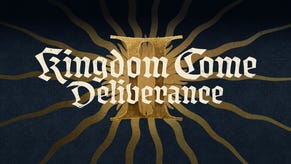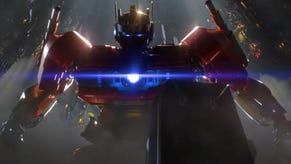Finding the Soul of Soulslikes - the devs riffing on the genre
“If you look at the original Dark Souls, it’s almost like an album from the band that came up with a new genre. You can take each song apart and have a sub-genre just as fun, it will find its own niche.”
That’s Vitaly Bulgarov, co-founder of developers Cold Symmetry, discussing the impact that Dark Souls had on their game Mortal Shell. This third-person action RPG, released in August, is one of a growing number of ‘soulslikes’ - games that are heavily inspired by the Souls series.
These games, developed by FromSoftware, have captured the imaginations of players and developers alike with their fascinating worlds, intricate level design, gripping gameplay and harsh difficulty since the release of Demon’s Souls in 2009. As FromSoftware experimented with the formula, most notably with Bloodborne in 2015 and Sekiro: Shadows Die Twice in 2019, others started to take elements of these games and put them into their own.
For example, ‘Estus Flask’ healing mechanics that force the player to heal in real-time, with a limited number of uses. ‘Bonfires’ are also common - these resting points refill the player’s flasks, respawn defeated enemies and act as the only way to save progress, just like the Souls series. Combat generally uses mechanics like stamina bars to encourage a tactical approach, while worldbuilding is often reliant on environmental storytelling and item descriptions rather than cutscenes and exposition.
However, many soulslikes deviate from some of these ‘central’ mechanics. So, ahead of Bluepoint Games’ remaster of Demon’s Souls, releasing as a PS5 launch title, I was keen to find out exactly what defines a soulslike - difficulty? Cryptic NPCs? A dark, brooding atmosphere? Or maybe something less easily definable?
In a Nutshell
Bulgarov spoke to me with his fellow Cold Symmetry co-founders Anton Gonzalez and Andrew McLennan-Murray, bar Dmitry Parkin. Bulgarov has a rack of swords on the wall behind him during our Zoom call - an interest that he credits Dark Souls for helping to spark.

“The one thing we all share in common is that Souls is extremely meaningful to all of us… psychologically or philosophically, we feel like it changed our lives to play the game,” McLennan-Murray says.
Cold Symmetry felt that there was a gap in the market for a game that tried to evoke the deeper emotional experience of the Souls series, eventually resulting in the third-person Soulslike Mortal Shell. The game’s setting, Fallgrim, has many resemblances to FromSoft’s games - the dark atmosphere, difficult melee combat, unusual NPCs that give cryptic information - but the team were conscious to mix it up.
Aggression is heavily incentivised by the ‘hardening’ mechanic, which briefly turns the player into an invulnerable statue. Estus Flasks have also been tossed away, replaced by a limited number of consumables, to incentivise the player to engage with the health-leeching parrying mechanic. You can even play the lute.
Other changes were born out of necessity - for example, they couldn’t recreate the wealth of armour, weapon and build options on offer in Dark Souls and instead focused on four distinct ‘Shells’ inspired by their preferred playstyles in Souls games, each with its own backstory.
McLennan-Murray describes crawling through storm drains as a child in Arizona, drawing a direct parallel between that and the tunnels that link Mortal Shell’s world together - the threat of drowning during monsoon season was “part of the excitement.”
This sense of intrigue was key for the team, who were heavily inspired by Dark Souls’ approach to storytelling. “It felt like you’re really discovering bits and pieces of a secret lore that you can’t really piece together,” Bulgarov says, comparing the experience to imagery evoked by a book. “That creates a sense of this magic in the world, that there’s things that are yet to be discovered.”
However, the team were keen to inject humour and character into Mortal Shell. For example, there’s a cat you can pet. The NPC Sester Genessa will have a little dance if you play the lute for her. She even laughs if you get caught in a bear trap.
“Every time someone steps on a bear trap, I get a little bit of joy inside,” McLennan-Murray says as the team cracks up laughing.
Their original prototype, Dungeonhaven, heavily focused on procedural generation. However, they felt that this approach “ran at odds end with really making a good Soulslike”, and opted for a hand-crafted approach instead. Effectively, they wanted players to feel like they were going on an adventure, inspired by the interconnectivity of the first Dark Souls.
“It felt like you went to the end of the world and back on foot. The sense of traversing a physical space in these games… we felt like it’s unparalleled. That was definitely a touchstone for us,” Bulgarov says.
Mortal Shell is a tough game, a decision also informed by the notoriously challenging Souls series.
“It requires the player to muster the motivation to move forward as opposed to pulling them forwards. That’s one of the things that makes it feel so rewarding, is that it’s on you as the player to persist and to develop your skill,” McLennan-Murray says.
Since the game is so tough, it was crucial to create a world that was captivating and authentic, according to Gonzalez.
“As soon as you can spark curiosity in the player, as soon as you can spark [their] imagination and the will to move forward... that’s the feeling that we wanted to achieve,” Gonzalez says.
Another Dimension
Blasphemous, a gorgeous yet gruesome 2D platformer casts the player as The Penitent One, a speechless warrior undergoing a pilgrimage through the nightmarish Cvstodia. The idea for Blasphemous came out of the third prototype produced by developers The Game Kitchen after creating the episodic point-and-click adventure series The Last Door.

“The final answer was: ok, we are like a simplified version of [Dark Souls] in 2D. That was our commitment and that was what we tried to deliver,” Enrique Colinet, Game Designer at The Game Kitchen, tells me.
They had to reject many of the gameplay elements found in Souls games, like consumables, experience points and varied weapon types due to their small team size. However, these limitations would help to shape the game into something unique.
“This is why we made the Mea Culpa (the player’s sword) such an important element of the game, because we couldn’t afford having more weapons and that’s it. It was a really smart decision in the end,” Colinet says.
Colinet rejected traditional metroidvania design in favour of a more open approach inspired by Dark Souls. For example, the player can take various paths and fight multiple different bosses from the very beginning. Colinet praised the sense of exploring uncharted territory evoked by Souls games, making the player curious to find out more.
“That’s a really powerful thing,” Colinet says. “There were so many answers that we could find in Dark Souls that it just fit the vision that we had for Blasphemous.”
The Game Kitchen also wanted combat to be Souls-y, but encountered difficulties recreating Dark Souls’ sense of agency. Having one less dimension meant that the player’s movement options were limited and the team couldn’t afford to create enemies with more than one attack. However, they decided to group various enemy types with different attacks together to create more interesting combat situations.
All that being said, Colinet has mixed feelings about elements of Dark Souls that he wanted to address with Blasphemous, particularly its tendency to wrong-foot players.
“Dark Souls is about p**sing the player [off] when they get used to something,” Colinet says, laughing. “Players got used to that, so they know that if things are going well at some point, something will change completely.” He pointed to boss fights getting ten times harder in their later stages and random item chests being dangerous mimics. For Blasphemous, Colinet wanted his levels to be challenging without being frustrating.
Additionally, Colinet felt that the Souls series could be too cryptic with information and wanted to ensure that Blasphemous was more legible. This was particularly important given the inspiration taken from Spanish culture, including its mythology and religious iconography, for Blasphemous. For example, the monstrous boss Lady of the Charred Visage was directly inspired by the story of a lady living in Seville hundreds of years ago, who poured burning oil over her face and became a nun to avoid getting married.
“There are so many things that we thought couldn’t influence a game or couldn’t be part of the fantasy of a game. Now that we know that this can work, it’s like we found a secret tunnel leading somewhere,” Colinet says.
The bonfire rhythm
James Silva’s first playthrough of Dark Souls was rough - he didn’t understand weapon scaling and was really bad at the game. However, things started to click once he began experimenting with different builds.

“That was the addiction for me, how much of a different game you could get by exploring different builds, how high the stakes were and how meaningful it felt to try out different builds,” Silva says.
Silva created Ska Studios in 2007 and developed Salt and Sanctuary, a 2D Soulslike with strong metroidvania elements inspired by Symphony of the Night. Silva was the primary developer, with assistance from Michelle Juett Silva. You play as a character shipwrecked by a monstrous kraken exploring a dark and atmospheric world.
Silva wanted to capture the series’ distinctive sense of exploration. He recalls showcasing Salt and Sanctuary at BitSummit in Kyoto, where the Souls series creator Hidetaka Miyazaki and other FromSoftware staffers played the game. When they got to the first sanctuary, the game’s equivalent to bonfires, they laughed.
“There’s that like - raauugh!” Silva says, enthusiastically mimicking the sound effect. “It was such a ‘bonfire’ moment, so they liked that.”
Silva also wanted to nail Dark Souls’ distinctive combat ‘dance’, pointing to the infamous Black Knight enemy encountered early in the first Dark Souls as an example.
“He will chase you and he will continue to chase you, you can block him but he will wear down your stamina. That level of aggression, for Salt and Sanctuary, was next to impossible to get but that was the goalpost” Silva says, leaning on hovering and teleporting enemies and ranged attacks to keep the pressure on.
Implementing a stamina bar was also crucial, forcing players to act tactically. For example, should you try to block an incoming attack that would drain your stamina, take a risk and try to dodge-roll through it, attempt a parry, or maybe just leg it?
“Without the stamina bar, it’s just button mashing. You’re not making decisions and then the dance doesn’t exist… it’s a great dimension that it adds to combat,” Silva says.
Although it can be simplified as ‘2D Dark Souls’, Salt and Sanctuary establishes its own personality as you get to grips with it. Enemies can be launched into the air and juggled with combos. Your character feels significantly more nimble than the Chosen Undead, with unlockable movement abilities as you progress. There’s also a darkly comic streak to the game, thanks to the ghoulish art style that lets you play as, say, a chef wielding an iron pot.
Although Silva feels that the game’s similarities to Dark Souls helped it to receive attention, he feels torn about the association.
“I put so much effort into the game and I put so much of my own voice into the game, but everyone who plays it and likes it is like ‘yeah I love this game because I love Dark Souls’,” Silva says.
“I can’t be upset about it, the attention it’s got has been awesome, it’s really been amazing, but it’s definitely a weird point.”
Taking a Shot
Remnant: From the Ashes stands out from the Soulslike crowd as a third-person co-op focused shooter with randomised level layouts and enemy positioning. Principal Designer Ben Cureton is a long-time fighting game fan and gravitated towards Souls games as tough-but-fair experiences that reward player skill.

Gunfire Games felt that they wanted to do justice to the idea of a gun-based Soulslike. However, this presented several issues: ranged combat in Dark Souls is generally easier than melee and playing co-op can make many boss encounters significantly easier.
“I always felt like it was a hollow victory,” Cureton says, particularly when compared to the satisfaction of fighting bosses solo “for hours and hours and hours, trying to figure out the patterns.”
Cureton wanted players to feel like they were working together to take down a boss. The solution was ‘adds’, weaker enemies that attack the player during a boss battle. Adds kept the player moving, prevented them from tearing through melee bosses quickly and placed a greater emphasis on movement and environment interaction.
“These things are designed specifically to reduce that inherent advantage that the player has from being able to sit at range,” Cureton says.
Remnant has various mechanical differences to the core FromSoftware titles, but arguably most notable is its random level generation, a feature not found in any of the main Souls series bar Bloodborne’s optional chalice dungeons. Cureton tells me that this was done to make the game replayable in the long term without becoming a “memory game”.
“You have your tools and then we put you in scenarios that are very familiar but not exactly the same. You have to adapt to those, so it feels like your skill and your preparation has been worth it, that investment has been worth it,” Cureton says.
For Remnant, they wanted each weapon to feel like a unique tool as opposed to a looter-shooter like Borderlands, where guns can be objectively better or worse. For example, the Particle Accelerator is a rifle that fires a gravity core on cooldown, dragging a cluster of enemies into a miniature black hole before exploding outwards, but I stuck with my good ol’ hunting rifle more often than not.
This was informed by Cureton’s love for the collection element of Souls games. Weapons in the series generally aren’t strictly better or worse than each other, setting themselves apart with interesting movesets or by suiting particular builds. Cureton compares it to a toolbox: you wouldn’t use a screwdriver to hammer a nail, or bring a knife to a dragon fight.
What’s in a name?
I was curious to learn how these developers felt about their games being labelled as soulslikes. Mortal Shell wears its Souls influence on its sleeve - the official announcement trailer even says that the game “takes inspiration from the soulslike realm” in the video description.
“We never tried to say that we are not what we really are. We got inspired from those games and we of course took a lot of references from there” Gonzalez says.
All developers interviewed for this piece view the label as a positive thing, acting as a useful description for players.
“A genre was spawned” Silva says, one that when “appropriately applied” lets the player expect gameplay elements like bonfires, Estus healing, difficult bosses and a focus on exploration.
Colinet agreed but questioned whether soulslikes are actually a genre rather than a collection of mechanics which could be applied to various types of games, like racing games.
“If ‘soulslike’ helps people to understand how your game is built, totally fine, it’s like ‘metroidvania’ - it helps people to understand what to expect” Colinet says.
Bulgarov feels that the term has a utility but argues that it has a potentially “misleading” connotation.
“If you make a deviation from [soulslike tropes], are you no longer soulslike? I mean, who cares? If it’s a great game, does it really matter?” Bulgarov argues.
For Remnant, the soulslike label can also have some negative connotations. For example, some people take the term to mean that the game will be melee-focused and may be disappointed that it’s primarily a shooter, according to Cureton.
“If it draws more people in to play, that’s great, but we don’t want to mis-represent just to draw people in... as long as there’s similarities [to soulslikes], but at the same time we’re trying to carve out our own version of that, I don’t think there’s anything wrong with it.”
Whatever a soulslike is, these games are all gripping. Their focus on aggressive and tactical combat fully immerses you in the moment, something Bulgarov describes as a sense of presence, and makes every victory feel like an achievement.
You might only ever understand 10 per cent of what the hell’s going on, but the true magic of these worlds is that the story comes alive in the hidden details, the gaps of knowledge that you have to fill in yourself. Hopefully that’s something a new generation of players can experience with the Demon’s Souls remaster, perhaps inspiring the next generation of soulslikes.
Demon's Souls is out now on PlayStation 5. We've got plenty of coverage on the site if you're struggling with any of its bosses or systems.




.jpg?width=291&height=164&fit=crop&quality=80&format=jpg&auto=webp)




